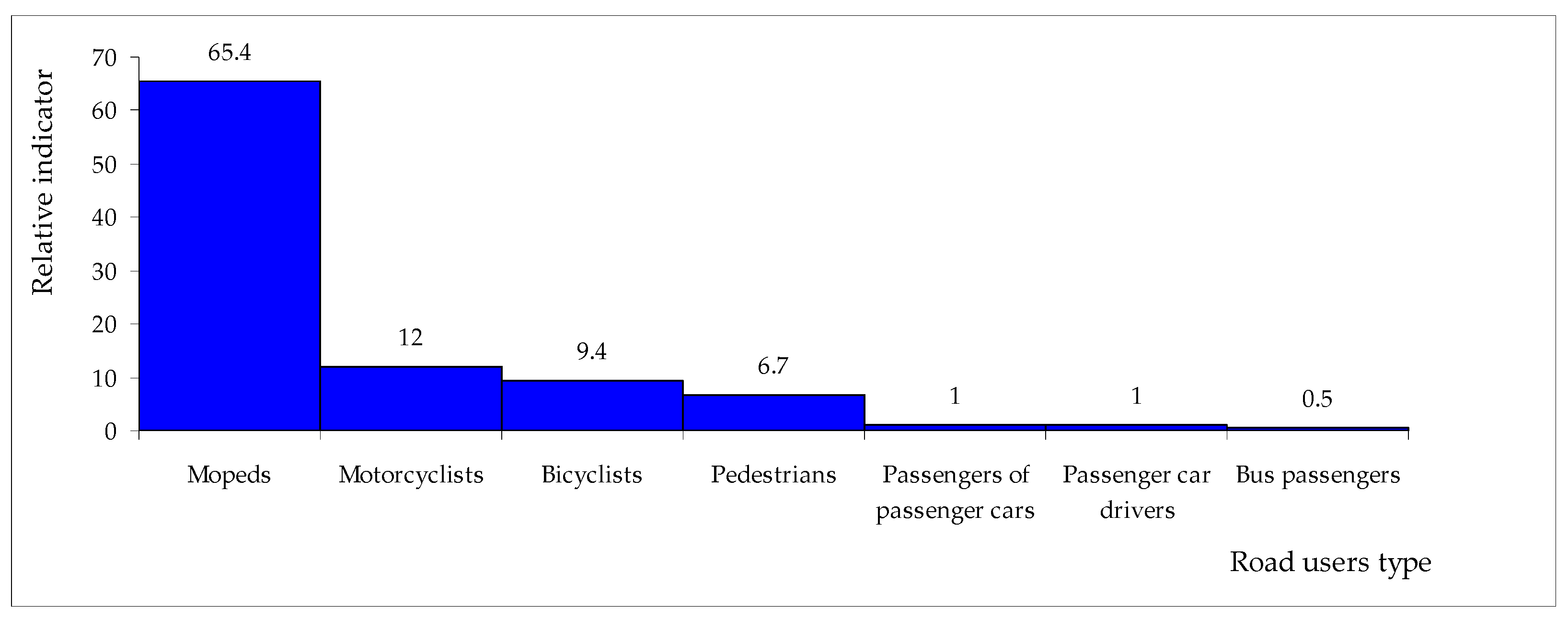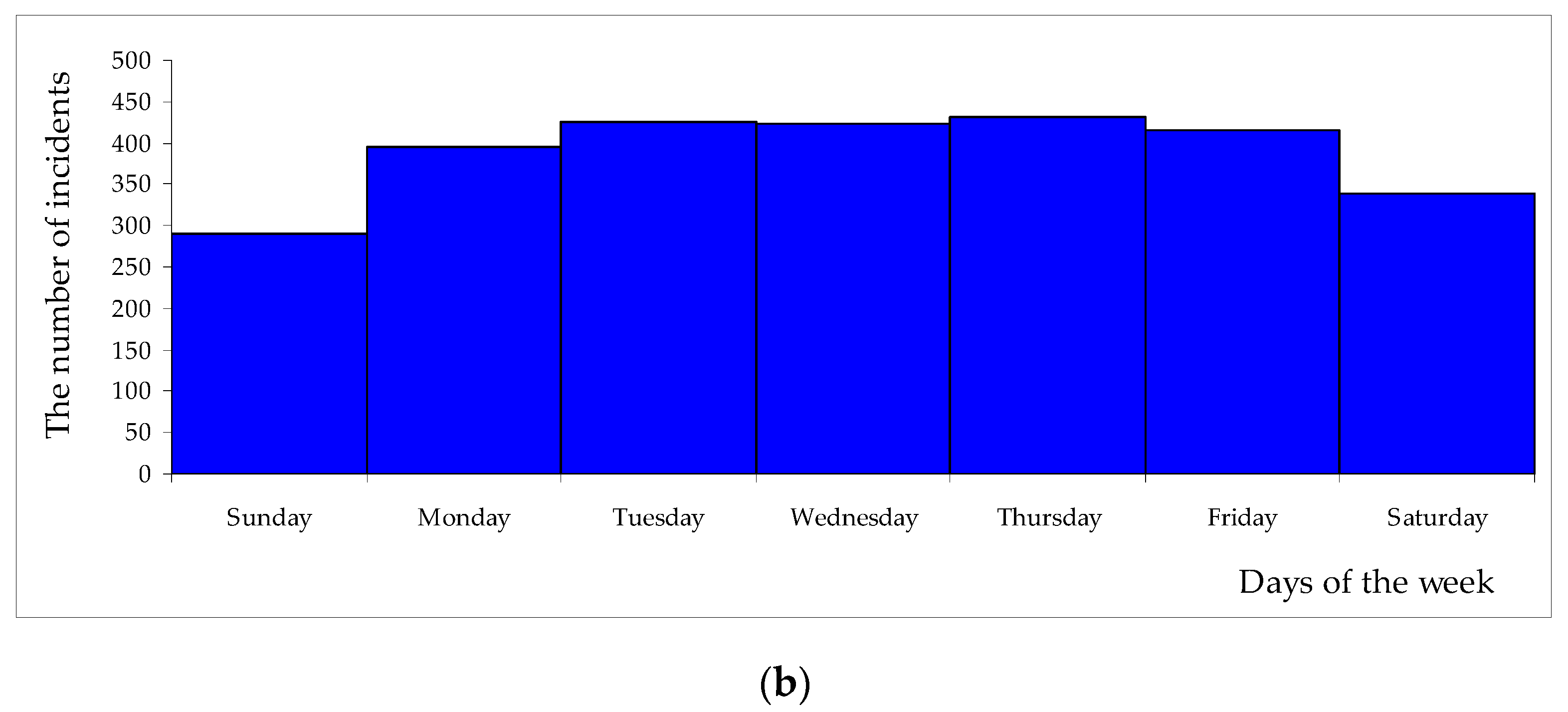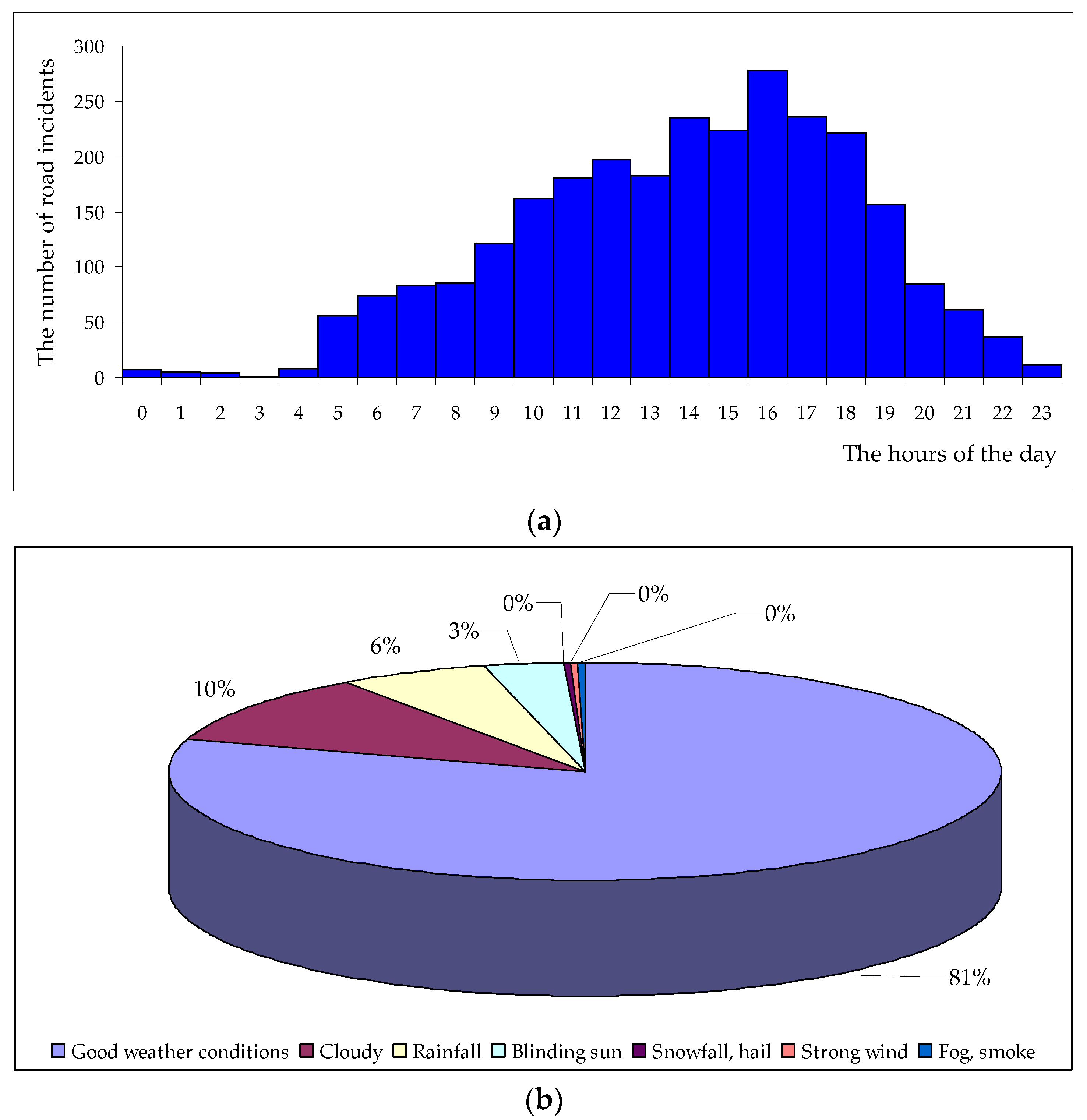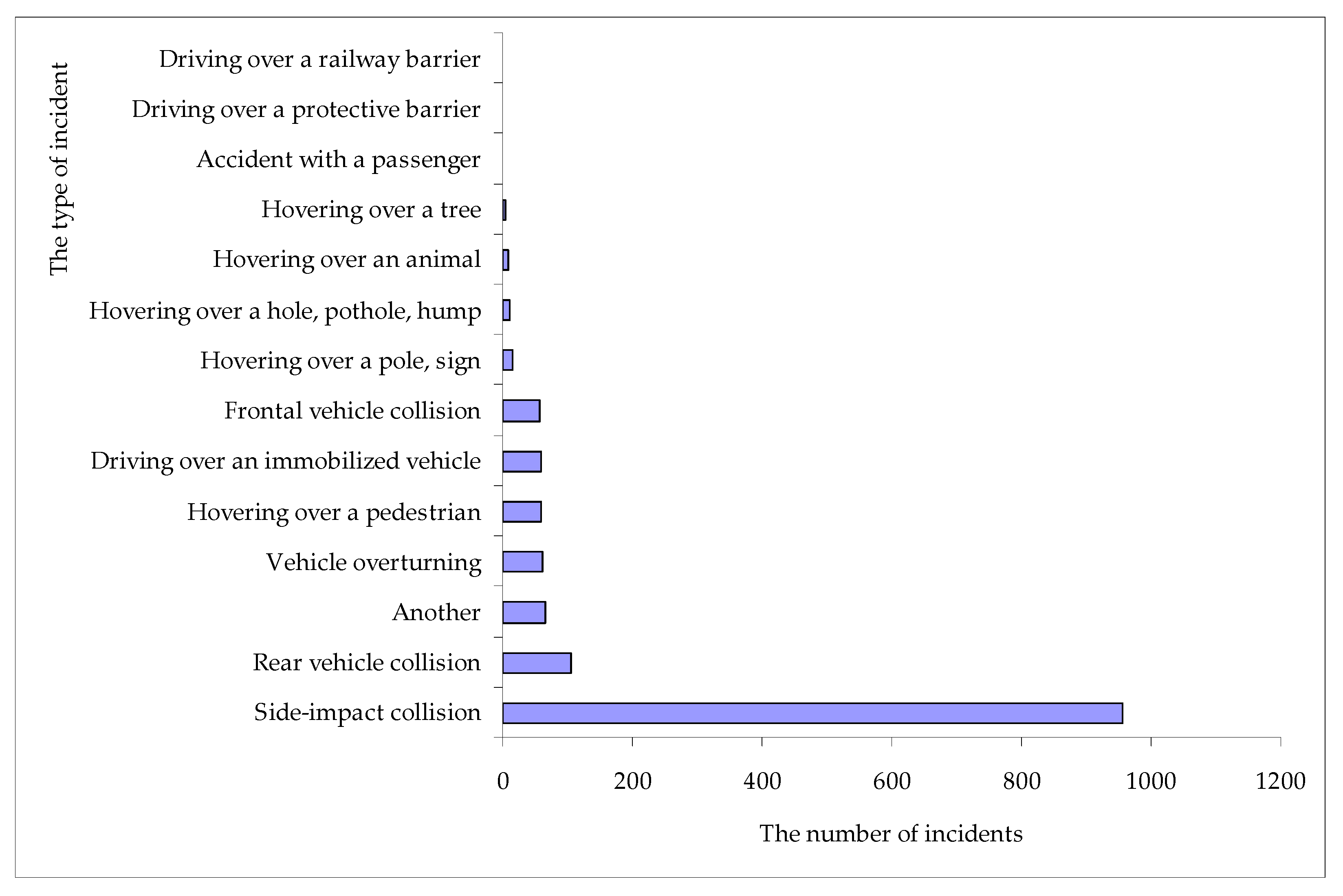The Analysis of the Factors Influencing the Severity of Bicyclist Injury in Bicyclist-Vehicle Crashes
Abstract
:1. Introduction
2. Literature Studies in the Field of Research Concerning Bicyclists Safety Analysis
- bicycle characteristics—e.g., bicycle speed before crash, bicyclist drinking, bicyclist vision obscured/not obscured, bicyclist distraction/lack of bicyclist distraction, helmet-wearing/no helmet, drug use, gender (female, male);
- vehicle driver characteristics—e.g., vision obscured, driver drinking, gender (female, male), vehicle condition (defective/not defective), vehicle driver vision obscured/not obscured, vehicle driver distraction/non-distraction, drug use;
- vehicle characteristics—e.g., vehicle speed before crash, vehicle type (passenger car vehicle, SUV, truck, van, division into small and large vehicles), vehicle condition (without defects, with a technical defect)
- environmental characteristics—e.g., lighting conditions (dawn, daylight, dusk, darkness—road lit, darkness road unlit), weather conditions (no rainfall, rainfall);
- roadway characteristics—e.g., two-way divided unprotected, two-way divided median, one way roadway, vertical alignment (straight, curve), vertical alignment level (grade, hillcrest, dip), horizontal align curve, location (no intersection, intersection of a given type, traffic control), number of intersection arms (two approaches, three approaches, four or more approaches), location-zone (school zone, out-of-school zone, work zone), road surface type (concrete, asphalt, gravel, stone, cobblestone), surface condition road (dry, wet)
3. Materials and Methods
- database containing information on all types of road incidents registered by the Police in Poland since 2007 (Accident and Collision Recording System (ACRS) [3]),
- data from the Traffic Control Center (TCC). TCC records and archiving of information about road traffic and road scene at transport network covered by the area traffic control system have been taking place continuously since 2013. The database created in this way enables the analysis of necessary data such as vehicle and bicycle characteristics and accident circumstances. The TCC is connected to Intelligent transport systems which use advanced technologies in the field of remote sensing, data collection, information processing, telecommunications, and traffic control to meet the current transport needs,
- orthophoto maps from publicly available websites in order to inventory the road/intersection, road geometry, and type of road surface. The ortophoto maps it is a raster image of the terrain surface, resulting from the processing of aerial or satellite images, thanks to which it was possible to identify the necessary data.
- only incidents involving a bicyclist and a motor vehicle were analyzed,
- the data relates to working days, i.e., from Monday to Friday. Weekend days (i.e., Saturdays and Sundays) were not included in the analysis, as these days are characterized by a lower traffic volume and thus by different traffic and accident characteristics.
4. Analysis of Selected Features of Road Incidents Involving Bicyclists
5. Modeling of the Severity of Bicyclist Injury in Bicyclist-Vehicle Crashes
5.1. Binomial Logit Model as a Modeling Technique
5.2. Dependent and Explanatory Variables
- 1 = bicyclist with severe and fatal injuries and
- 0 = slightly injured bicyclist.
5.3. The Factors Influencing the Occurrence and Severity of Bicyclist Injury in Bicyclist-Vehicle Crashes
- vehicle driver characteristics: gender (X1) and age (X2), intoxicated driver (X3), exceeding the speed limit (X6),
- bicyclist characteristics: bicyclist age (X8), intoxicated bicyclist (X9), bicyclist speed before the incident (X10),
- vehicle characteristics: vehicle type (X11),
- road characteristics: incident place (X14),
- environmental characteristic: time of the day (X19),
- accident characteristics: the type of incident (X21).
- decreases by 21% when the vehicle driver is a female and other variables remain unchanged,
- increases by 47% if the vehicle driver is a young (up to 60 years old), cetis paribus,
- increases by 29% in the case when the vehicle driver is intoxicated, cetis paribus,
- increases by as much as 92% when the vehicle driver exceeds the speed limit, cetis paribus,
- increases by 13% if the bicyclist is older than 60 years old, cetis paribus,
- increases by 11% if the bicyclist is a intoxicated, cetis paribus,
- increases by as much as 84% if the bicyclist exceeded speed = 30 km/h, cetis paribus,
- increases by as much as 72%, if the vehicle is truck, cetis paribus,
- increases by 55% if the accident happened on the road area, cetis paribus,
- increases by 59% if the crash occurred during nighttime, i.e., from 22:00 p.m. to 6:00 a.m., cetis paribus,
- increases by 65% if the crash was a head-on collision, cetis paribus.
6. Discussion
7. Conclusions
Author Contributions
Funding
Institutional Review Board Statement
Informed Consent Statement
Data Availability Statement
Acknowledgments
Conflicts of Interest
References
- European Transport Safety Council. Available online: https://www.brd24.pl/technologie/europejski-raport-rowerzystach-polska-niebezpieczna/ (accessed on 15 July 2021).
- Eurostat Data. Available online: https://ec.europa.eu/eurostat/web/main/data/database (accessed on 15 July 2021).
- Accident and Collision Record System. Available online: http://sewik.pl/search (accessed on 16 July 2021).
- Elvik, R.; Høye, A.; Vaa, T.; Sørensen, M. The Handbook of Road Safety Measures, 2nd ed.; Emerald Group Publishing: Bingley, UK, 2009. [Google Scholar]
- Macioszek, E.; Kurek, A.; Kowalski, B. Overview of safety at rail-road crossings in Poland in 2008–2018. Transp. Probl. 2020, 15, 57–68. [Google Scholar] [CrossRef]
- Klop, J.R.; Khattak, A.J. Factors influencing bicycle crash severity on two-lane, undivided roadways in North Carolina. Transp. Res. Rec. J. Transp. Res. Board 1999, 1674, 78–85. [Google Scholar] [CrossRef]
- Robartes, E.; Chen, T.D. The effect of crash characteristics on cyclist injuries: An analysis of Virginia automobile-bicycle crash data. Accid. Anal. Prev. 2017, 104, 165–173. [Google Scholar] [CrossRef]
- Behnood, A.; Mannering, F. Determinants of bicyclist injury severities in bicycle-vehicle crashes: A random parameters approach with heterogenity in means and variances. Anal. Methods Accid. Res. 2017, 16, 35–47. [Google Scholar] [CrossRef]
- Kim, J.K.; Kim, S.; Ulfarsson, G.F.; Porrello, L.A. Bicyclist injury severities in bicycle-motor vehicle accidents. Accid. Anal. Prev. 2007, 39, 238–251. [Google Scholar] [CrossRef] [PubMed]
- Wang, T.; Chen, J.; Wang, C.; Xiaofei, Y. Understand e-bicyclist safety in China: Crash severity modeling using a generalized ordered logit model. Adv. Mech. Eng. 2018, 10, 1–11. [Google Scholar] [CrossRef] [Green Version]
- Liu, S.L.; Fan, W.D. Investigating factors affecting injury severity in bicycle-vehicle ceashes: A day-of-week analysis with partial proportional odds logit models. Can. J. Civ. Eng. 2021, 48, 941–947. [Google Scholar] [CrossRef]
- Olivier, J.; Creighton, P. Bicycle injuries and helmet use: A systematic review and meta-analysis. J. Epidemiol. 2017, 46, 278–292. [Google Scholar] [CrossRef] [PubMed] [Green Version]
- Rivara, F.P.; Thompson, D.C.; Thompson, R.S. Epidemiology of bicycle injuries and risk factors for serious injury. Injury Prev. 1997, 3, 110–114. [Google Scholar] [CrossRef]
- Moore, D.N.; Schneider, W.H., 4th; Savolainen, P.T.; Farzaneh, M. Mixed logit analysis of bicyclist injury severity resulting from motor vehicle crashes at intersection and non-intersection locations. Accid. Anal. Prev. 2011, 43, 621–630. [Google Scholar] [CrossRef] [PubMed]
- Kaplan, S.; Vavatsoulas, K.; Prato, C.G. Aggravating and mitigating factors associated with cyclist injury severity in Denmark. J. Saf. Res. 2014, 50, 75–82. [Google Scholar] [CrossRef]
- Hu, F.; Lv, D.; Zhu, J.; Fang, J. Related Risk Factors for Injury Severity of E-bike and Bicycle Crashed in Hefei. Traffic Inj. Prev. 2014, 15, 319–323. [Google Scholar] [CrossRef] [PubMed]
- Eluru, N.; Bhat, C.R.; Hensher, D.A. A mixed generalized ordered response model for examining pedestrian and bicyclist injury severity level in traffic crashes. Accid. Anal. Prev. 2008, 40, 1033–1054. [Google Scholar] [CrossRef] [Green Version]
- Chen, P.; Shen, Q. Built environment effects on cyclist injury severity in automobile-involved bicycle crashes. Accid. Anal. Prev. 2016, 86, 239–246. [Google Scholar] [CrossRef] [PubMed]
- Yan, X.; Ma, M.; Huang, H.; Abdel-Aty, M.; Wu, C. Motor vehicle-bicycle crashes in Beijing: Irregular maneuvers, crash patterns, and injury severity. Accid. Anal. Prev. 2011, 43, 1751–1758. [Google Scholar] [CrossRef]
- Myhrmann, M.S.; Janstrup, K.H.; Moller, M.; Mabit, S.E. Factors influencing the injury severity of single-bicycle crashes. Accid. Anal. Prev. 2021, 149, 105875. [Google Scholar] [CrossRef]
- Bahrololoom, S.; Young, W.; Logan, D. Modelling injury severity of bicyclists in bicycle-car crashes at intersections. Accid. Anal. Prev. 2020, 144, 105597. [Google Scholar] [CrossRef]
- Wang, Z.; Huang, S.; Wang, J.; Sulaj, D.; Hao, W.; Kuang, A. Risk factors affecting crash injury severity for different groups of e-bike roders: A classification tree-based logistic regression model. J. Saf. Res. 2021, 76, 176–183. [Google Scholar] [CrossRef]
- Chen, P.; Shen, Q. Identifying high-risk built environments for severe bicycling injuries. J. Saf. Res. 2019, 68, 1–7. [Google Scholar] [CrossRef] [PubMed]
- Chen, P. Built environment factors in explaining the automobile-involved bicycle crash frequesncies: A spatial statistic approach. Saf. Sci. 2015, 79, 336–343. [Google Scholar] [CrossRef]
- Fountas, G.; Fonzone, A.; Olowosegun, A.; McTigue, C. Addressing unobserved heterogenity in the analysis of bicycle crash injuries in Scotland: A correlated random parameters ordered probit approach with heterogenity in means. Anal. Methods Accid. Res. 2021, 32, 100181. [Google Scholar] [CrossRef]
- Rahman, M.S.; Abdel-Aty, M.; Hasan, S.; Cai, Q. Applying machine learning approaches to analyze the vulnerable road-users charshes at statewide traffic analysis zones. J. Saf. Res. 2019, 70, 275–288. [Google Scholar] [CrossRef]
- Wang, C.; Kou, S.; Song, Y. Identify risk pattern of E-bike riders in China based on machine learning framework. Entropy 2019, 21, 1084. [Google Scholar] [CrossRef] [Green Version]
- Shirani-Bidabadi, N.; Mallipaddi, N.; Haleem, K.; Anderson, M. Developing bicycle-vehicle crash-specific safety performance functions in Alabama using different techniques. Accid. Anal. Prev. 2020, 146, 105735. [Google Scholar] [CrossRef]
- Seva, R.R.; Flores, G.M.T.; Gotohio, M.P.T.; Paras, N.G. Logit model of motorcycle accidents in the Philipines considering personal and environmental factors. Int. J. Traffic Transp. Eng. 2013, 3, 173–184. [Google Scholar] [CrossRef] [Green Version]
- Boufous, S.; de Rome, L.; Senserrick, T.; Ivers, R. Risk factors for severe injury in cyclists involved in traffic crashes in Victoria, Australia. Accid. Anal. Prev. 2012, 49, 404–409. [Google Scholar] [CrossRef] [PubMed]
- Li, Y.; Fan, W.D. Pedestrian Injury Severities in Pedestrian-Vehicle Crashes and the Partial Proportional Odds Logit Model: Accounting for Age Difference. Transp. Res. Rec. 2019, 2673, 1–16. [Google Scholar] [CrossRef]
- Ambo, T.B.; Ma, J.; Fu, C. Investigating influence factors of traffic violation using multinomial logit mehod. Int. J. Inj. Control. Saf. Promot. 2021, 28, 78–85. [Google Scholar] [CrossRef]
- Intini, P.; Berloco, N.; Fonzone, A.; Fountas, G.; Ranieri, V. The influence of traffic, geometric and context variables on urban crash types: A grouped random parameter multinomial logit approach. Anal. Methods Accid. Res. 2020, 28, 100141. [Google Scholar] [CrossRef]
- Celik, A.K.; Oktay, E. A multinomial logit analysis of risk factors influencing road traffic injury severities in the Erzurum and Kars Provinces of Turkey. Accid. Anal. Prev. 2014, 72, 66–77. [Google Scholar] [CrossRef] [PubMed]
- Macioszek, E. The application of HCM 2010 in the determination of capacity of traffic lanes at turbo roundabout entries. Transp. Probl. 2016, 11, 77–89. [Google Scholar] [CrossRef] [Green Version]
- Traffic Control Data. Available online: https://its.gliwice.eu/ (accessed on 3 June 2021).
- Terms Used in Official Statistics. Available online: https://translate.google.pl/?sl=pl&tl=en&text=Poj%C4%99cia%20stosowane%20w%20statystyce%20publicznej&op=translate (accessed on 3 May 2021).
- Regulation No. 31 of the Police Commander in Chief of October 26, 2015 on the Methods and Forms of Statistics of Road Incidents Conducted by the Police. Available online: https://www.infor.pl/akt-prawny/U27.2015.048.0000085,zarzadzenie-nr-31-komendanta-glownego-policji-w-sprawie-metod-i-form-prowadzenia-przez-policje-statystyki-zdarzen-drogowych.html (accessed on 30 April 2021).
- Order No. 40 of the Police Commander in Chief of December 18, 2017 Amending the Regulation on the Methods and Forms of Conducting Statistics on Road Incidents by the Police. Available online: https://isp.policja.pl/isp/aktualnosci/prawo/12251,Zarzadzenie-nr-40-Komendanta-Glownego-Policji-z-dnia-18-grudnia-2017-r.html (accessed on 30 April 2021).
- PQStat. Statistical Calculation Software. Available online: https://pqstat.pl/?mod_f=log_reg (accessed on 1 June 2021).
- Greene, W.H. Econometric Analysis, 5th ed.; Prentice Hall: Plano, TX, USA, 2002. [Google Scholar]
- Cieślak, M. (Ed.) Prognozowanie Gospodarcze: Metody i Zastosowania; Wydawnictwo Naukowe PWN: Warszawa, Poland, 2008. [Google Scholar]
- Macioszek, E.; Kurek, A. P&R parking and bike-sharing system as solutions supporting transport accessibility of the city. Transp. Probl. 2020, 15, 275–286. [Google Scholar] [CrossRef]
- Żochowska, R.; Jacyna, M.; Kłos, M.J.; Soczówka, P. A GIS-based method of the assessment of spatial integration of bike-sharing stations. Sustainability 2021, 13, 3894. [Google Scholar] [CrossRef]
- Oskarbski, J.; Birr, K.; Żarski, K. Bicycle traffic model for sustainable urban mobility planning. Energies 2021, 14, 5970. [Google Scholar] [CrossRef]
- Li, Y.; Fan, W. Modeling the severity of pedestrian injury in pedestrian-vehicle crashes in North Carolina: A partial proportional odds logit model approach. Accid. Anal. Prev. 2018, 131, 284–296. [Google Scholar] [CrossRef] [PubMed]
- Guohua, L.; Baker, S.P.; Smialek, J.E.; Soderstrom, C.A. Use of alkohol as a risk factor for bicycling injury. JAMA New. 2001, 285, 893–896. [Google Scholar] [CrossRef] [Green Version]
- Samerei, S.A.; Aghabak, K.; Shiwakoti, N.; Mohammadi, A. Using latent class clustering and binary logistic regression to model Australian cyclist injury severity in motor vehicle-bicycle crashes. J. Saf. Res. 2021, 79, 246–256. [Google Scholar] [CrossRef]
- Scheiman, S.; Moghaddas, H.S.; Bjornstig, U.; Bylund, P.O.; Saveman, B.I. Bicycle injury evens among older adults in Northen Sweden: A 10-year population based study. Accid. Anal. Prev. 2010, 42, 758–763. [Google Scholar] [CrossRef]
- Namini, N.K.; Lee, A.W.; Amend, G.M.; Vargo, J.; Breyer, B. Impact of alkohol and drug use on bicycle and electric scooter injuries and hospital admissions in the United States. Sage J. 2021, 1–9. [Google Scholar] [CrossRef]
- Smink, B.E.; Ruiter, B.; Lusthof, K.J.; De Gier, J.J.; Uges, D.R.; Egberts, A.C. Drug use and the severity of a traffic accident. Accid. Anal. Prev. 2005, 37, 427–433. [Google Scholar] [CrossRef]
- Killops, J.; Sewry, N.A.; Schwellnus, M.; Swanevelder, S.; van Rensburg, D.J.; Jordaan, E. Woman, Older Age, Faster Cycling Speed and Increased Wind Speeds Are Independent Risk Factors for Acue Injury-Related Medical Encounters During a 109 Km Mass Community-Based Paericipation Cycling Event: A 3-Yesr Study in 102251 Race Starters—Safer Xii. Available online: https://injuryprevention.bmj.com/content/27/4/338 (accessed on 4 June 2021).
- Macioszek, E.; Kurek, A. Roundabout users subjective safety—Case study from upper silesian and masovian voivodeships (Poland). Trans. Transp. Sci. 2020, 11, 39–50. [Google Scholar] [CrossRef]
- Pokorny, P.; Pitera, K. Truck-bicycle safety: An overview of methods of study, risk factors and research needs. Eur. Transp. Res. Rev. 2019, 11, 1–14. [Google Scholar] [CrossRef]
- Dablanc, L. Goods transport in large European cities: Difficult to organize, difficult to modernize. Transp. Res. Part A Policy Pract. 2007, 41, 280–285. [Google Scholar] [CrossRef]
- Jaller, M.; Holguín-Veras, J.; Hodge, S. Parking in the city: Challenges for freight traffic. Transp. Res. Rec. J. Transp. Res. Board 2013, 2379, 46–56. [Google Scholar] [CrossRef]
- Macioszek, E.; Kurek, A. Extracting road traffic volume in the city before and during COVID-19 through video remote sensing. Remote Sens. 2021, 13, 2329. [Google Scholar] [CrossRef]
- Macioszek, E. Changes in values of traffic volume—Case study based on general traffic measurements in opolskie voivodeship (Poland). Lect. Notes Netw. Syst. 2019, 51, 66–76. [Google Scholar] [CrossRef]
- Vandebulcke, G.; Thomas, I.; Panis, L.I. Predicting cycling accident risk in Brussels: A spatial case-control approach. Accid. Anal. Prev. 2014, 62, 341–357. [Google Scholar] [CrossRef]
- Allen-Munley, C.; Daniel, J. Urban bicycle route safety rating model—Application in Jersey City, New Jersey. J. Transp. Eng. 2006, 132, 499–507. [Google Scholar] [CrossRef]
- Hamann, C.; Peek-Asa, C. On-road bicycle facilities and bicycle crashes in Iowa, 2007–1010. Accid. Anal. Prev. 2013, 56, 103–109. [Google Scholar] [CrossRef]
- Raihan, A.; Alluri, P.; Wu, W.; Gan, A. Estimation of bicycle crash modification factors (CMFs) on urban facilities using zero inflated negative binomial models. Accid. Anal. Prev. 2019, 123, 303–313. [Google Scholar] [CrossRef]
- Zahabi, S.A.H.; Strauss, J.; Manaugh, K.; Miranda-Moreno, L.F. Estimating potential effect of speed limits, built environment, and other factors on severity of pedestrian and cyclist injuries in crashes. Transp. Res. Rec. 2011, 2247, 81–90. [Google Scholar] [CrossRef]
- Asgarzadeh, M.; Fisher, D.; Verma, S.K.; Courtney, T.K.; Christiani, D.C. The Impact of Weather, Road Surface, Time-of-Day, and Light Conditions on Severity of Bicycle-Motor Vehicle Crash Injuries. Am. J. Ind. Med. Inc. Environ. Occup. Health 2018, 1–10. [Google Scholar] [CrossRef] [PubMed]
- Bahrololoom, S.; Moridpour, S.; Tay, R. Factors Affecting Bicycle Fatal and Serious Injury Crashes in Victoria, Australia. Available online: https://www.australasiantransportresearchforum.org.au/sites/default/files/ATRF2016_Full_papers_resubmission_202.pdf (accessed on 4 June 2021).
- Bil, M.; Bilova, M.; Muller, I. Critical factors in fatal collisions of adult cyclists with automobiles. Accid. Anal. Prev. 2010, 42, 1632–1636. [Google Scholar] [CrossRef] [PubMed]








| The Author (-s) | Bicyclist Characteristics | Vehicle Driver Characteristics | Vehicle Characteristics | Environmental Characteristics | Roadway Characteristics | Time of the Year | Crash Characteristics |
|---|---|---|---|---|---|---|---|
| E. Robartes and T.D. Chen [7] |
|
|
|
|
| - | - |
| D. N. Moore et al. [14] |
|
|
| - |
|
|
|
| S. Kaplan et al. [15] |
|
|
|
|
| - |
|
| F. Hu et al. [16] |
|
|
| - | - | - | - |
| N. Eluru et al. [17] |
|
|
| - |
| - |
|
| P. Chen and Q. Shen [18] |
|
|
|
|
| - | - |
| X. Yan et al. [19] |
| - |
|
|
| - |
|
| M.S. Myhrmann et al. [20] |
| - | - |
|
|
| - |
| S. Bahrololoom et al. [21] |
| - | - | - |
| - |
|
| Z. Wang et al. [22] |
|
|
|
|
|
| - |
| P. Chen and Q. Shen [23] |
|
|
|
|
| - |
|
| P. Chen [24] |
| - | - |
|
| - | - |
| G. Fountas and al. [25] |
|
| - |
|
| - | - |
| Explanatory Variable Designation | Explanatory Variable Name | Explanatory Variable Description |
|---|---|---|
| Driver characteristics | ||
| X1 | Gender | =1 if the driver is a female, =0 otherwise |
| X2 | Age | =1 if the driver is a young (up to 60 years old), =0 otherwise (i.e., older than 60 years old) |
| X3 | Alcohol usage | =1 if the driver is an intoxicated, =0 otherwise |
| X4 | Experience (i.e., the number of years possesing the driver licence) | =1 if the driver caused crashes has an experience between (0–5) years, =0 otherwise |
| X5 | Possession of driving license | =1 if the driver has a driver license, =0 otherwise |
| X6 | Exceeding the speed limit | =1 If the driver exceeded posted speed limit, =0 otherwise |
| Bicyclist characteristics | ||
| X7 | Gender | =1 if the bicyclist is a male, =0 otherwise |
| X8 | Age | =1 if the bicyclist is older than 60 years old, =0 otherwise (i.e., up to 60 years old) |
| X9 | Alcohol usage | =1 if the bicyclist is a intoxicated, =0 otherwise |
| X10 | Speed before incident | =1 If the bicyclist exceeded speed = 30 km/h, =0 otherwise |
| Vehicle characteristics | ||
| X11 | Vehicle type | =1 if the vehicle is truck, =0 otherwise |
| Road characteristics | ||
| X12 | Speed limit | =1 if the vehicle is passenger car, =0 otherwise |
| X13 | Intersection | =1 if the accident happened in intersection area, =0 otherwise |
| X14 | Incident place | =1 if the accident happened on the road, =0 otherwise |
| X15 | Type of surface | =1 if the pavement is hard, =0 otherwise |
| X16 | Road geometry | =1 if the accident occurred on a straight section, =0 otherwise |
| X17 | Road type | =1 if the road is a one-way, =0 otherwise |
| Envinronmental characteristic | ||
| X18 | The type of the area | =1 if crash occurred on urban area, =0 otherwise |
| X19 | Time of the day | =1 if crash occurred during nighttime (i.e., from 22:00 p.m. to 6:00 a.m.), =0 otherwise |
| X20 | Weather conditions | =1 If crash occurred during the good weather condition, =0 otherwise |
| Accident characteristics | ||
| X21 | Incident type | =1 if crash was a head-on collision, =0 otherwise |
| Explanatory Variable Xk | αk | Wald Statistics | Significance Level p-Value | Exp(αi) |
|---|---|---|---|---|
| X1 | −0.231 | 5.880 | 0.108 | 0.794 |
| X2 | 0.387 | 6.868 | 0.112 | 1.473 |
| X3 | 0.251 | 6.490 | 0.104 | 1.285 |
| X6 | 0.651 | 6.027 | 0.107 | 1.917 |
| X8 | 0.125 | 18.971 | 0.125 | 1.133 |
| X9 | 0.101 | 42.224 | 0.000 * | 1.106 |
| X10 | 0.607 | 38.513 | 0.000 * | 1.835 |
| X11 | 0.541 | 4.823 | 0.097 | 1.718 |
| X14 | 0.439 | 7.374 | 0.114 | 1.551 |
| X19 | 0.461 | 3.952 | 0.076 | 1.586 |
| X21 | 0.502 | 32.155 | 0.100 | 1.652 |
| α0 | 7.340612 | |||
| H.R. (Hit Ratio) | ||||
| Log Likelihood | −63.281726 | |||
| -2 Log Likelihood | 126.563452 | |||
| Log Likelihood (for α0) | 85.89028 | |||
| 2 Log Likelihood (for α0) | 171,78056 | |||
| Chi-square statistics | 49.972028 | |||
| p-value | <0.00001 | |||
| Pseudo R2 | 0.287162 | |||
| R2 Nagelkerke | 0.412436 | |||
| R2 Coxa–Snella | 0.311029 | |||
| Hosmer–Lemeshow test results: | ||||
| Chi-square statistics | 12.801928 | |||
| p-value | 0.1927 |
Publisher’s Note: MDPI stays neutral with regard to jurisdictional claims in published maps and institutional affiliations. |
© 2021 by the authors. Licensee MDPI, Basel, Switzerland. This article is an open access article distributed under the terms and conditions of the Creative Commons Attribution (CC BY) license (https://creativecommons.org/licenses/by/4.0/).
Share and Cite
Macioszek, E.; Granà, A. The Analysis of the Factors Influencing the Severity of Bicyclist Injury in Bicyclist-Vehicle Crashes. Sustainability 2022, 14, 215. https://doi.org/10.3390/su14010215
Macioszek E, Granà A. The Analysis of the Factors Influencing the Severity of Bicyclist Injury in Bicyclist-Vehicle Crashes. Sustainability. 2022; 14(1):215. https://doi.org/10.3390/su14010215
Chicago/Turabian StyleMacioszek, Elżbieta, and Anna Granà. 2022. "The Analysis of the Factors Influencing the Severity of Bicyclist Injury in Bicyclist-Vehicle Crashes" Sustainability 14, no. 1: 215. https://doi.org/10.3390/su14010215







